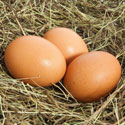
Lining your hens’ nests with something clean and soft protects eggs from getting cracked in the nest and also simplifies nest clean-out. Every chicken keeper has a favorite nest liner. Here are some poplar options:
Turf Nest Liner
Plastic turf nest pads have grass-like tufts on the upper side and a smooth surface on the underside. Numerous holes through the pads help prevent debris from sticking and make the pads easy to clean. In most cases all you need to do is remove the pad from the nest and hit it against something solid, such as a post or corner of the coop. Broken egg or other debris that sticks to the pad may be hosed off. These pads work best when they fit snugly into the nest, so the hens can’t scratch up the edges. Turf pads may be used with or without additional nesting material, such as wood shavings or chopped straw.
Excelsior Liner
Made of straw-like aspen fiber, excelsior pads are designed to be used without additional nesting material. Their advantage is that the eggs don’t get buried in nesting material, which can stick to the eggs and transfer into your egg collection basket. The disadvantage to excelsior is that it is not designed to be cleaned and reused, but must be replaced when it becomes soiled.
Repurposed Materials
A variety of durable materials may be cut to size and used as nest pads. They include asphalt shingles, yoga mats, outdoor carpet, boat or marine carpet, and corrugated cardboard. Cardboard pads have the advantage of being cheap to use and replace. They make nest clean-out easy: just fold the cardboard over the shavings or chopped straw, lift out the soiled nesting material with the cardboard, and toss it in the compost pile. The main disadvantage to cardboard is that, unless you replace it often, the hens will wear or peck a hole through the middle.
Sand Liner
A lot of chicken keepers don’t use any liners at all, but simply pad the nests with soft nesting material. Suitable materials, besides wood shavings or chopped straw, include shredded paper and well-dried chemical-free lawn clippings. Including a potpourri herbal infusion helps repel insect pests and gives the coop a pleasantly floral aroma.
Nesting material used alone, however, means broken eggs and chicken poop will stick to the nest bottom, making the nest difficult to clean. Even with a pad, poop or broken egg can migrate underneath and glue the pad to the nest bottom. Clean-up is much easier in a nest that’s sprinkled with washed river sand before the pad or nesting material is added.
And that’s today’s news from the Cackle Coop.
Gail Damerow, author, Storey’s Guide to Raising Chickens


Thank you so much! I can now improve the life of my chickens and make life easier by maintaining their coop cleaner. This is all new to me!